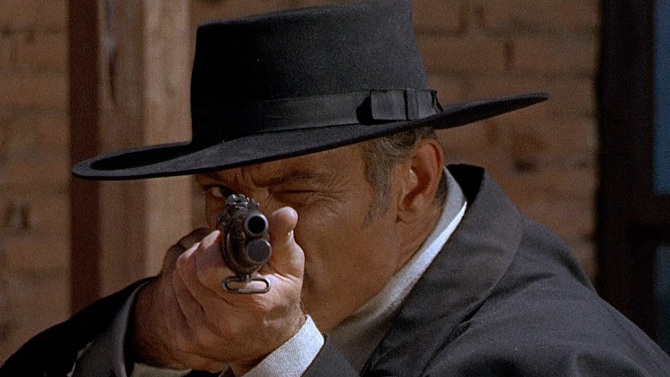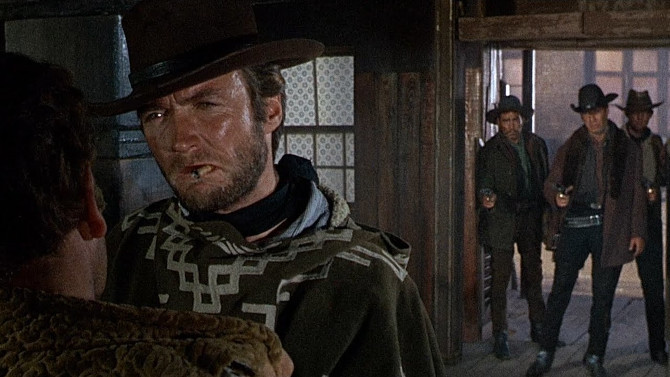“Where life had no value, death, sometimes, had its price. That is why the bounty killers appeared.”
Before we get started today, I just wanted to write something on Ennio Morricone, the iconic composer who passed away on July 6th, 2020. With a mind-blowing 519 composing credits to his name, he was a master of music. . . scoring everything from gialli (including Dario Argento’s famed “Animal Trilogy” – the first being The Bird with the Crystal Plumage) and spaghetti westerns (arguably his most famous work, the “Dollars Trilogy” with Sergio Leone) in his native Italy, to big budget Hollywood blockbusters such as Terrence Malick’s Days of Heaven, Brian De Palma’s The Untouchables, John Carpenter’s The Thing, Roland Joffé’s The Mission, Barry Levinson’s Bugsy, and Quentin Tarantino’s The Hateful Eight (which won him his only competitive Oscar). Today’s review of For a Few Dollars More (1965) is a prime example of his craftsmanship – a dynamic combination of diegetic and non-diegetic music (the former meaning a tune being heard by both the characters in the film and the audience, the latter being heard only by the audience), the score is built around the diegetic sounds of a musical pocket watch held by two different characters, yet this is only the beginning. . . listen for his fascinating combination of chanting, whistling, different sounds, and instrumental music that lingers somewhere between its nineteenth century western setting and some yet undiscovered post-modern style of music.
What do you want after getting A Fistful of Dollars? Obviously, you’re looking For a Few Dollars More. A spiritual sequel to Fistful, Sergio Leone utilizes an almost vignette-style format to set the stage. A story about bounty hunters, Col. Douglas Mortimer (Lee Van Cleef) is the sharpest shot in the west. . . an aging master tracker, he always seems to get his way along any path he takes. The same can be said about The Man With No Name (Clint Eastwood) – at one point nicknamed Monco (which means maimed, or missing an arm – you’ll notice he uses his left hand for everything other than shooting, his right always lingering under his poncho next to his gun), the younger, hotshot bounty hunter who speaks softly, but carries a big stick. . . I mean revolver.
After both successfully collecting different bounties, they learn that El Indio (Gian Maria Volontè) has been broken out of prison. . . carrying a ten thousand dollar bounty (dead or alive), he is a sick, twisted individual (who loves nothing more than to have a shoot-off that only starts after his musical pocket watch stops playing), and both hunters want this prize (though perhaps for very different reasons). A disturbed, depressed psychopath surrounded by a slew of equally vile henchmen, some of the most notable are crafty Groggy (Luigi Pistilli – also a noticeable face from the giallo craze – think Your Vice Is a Locked Room and Only I Have the Key or The Case of the Scorpion’s Tail), and the hunchbacked and quick to anger Juan Wild (the great Klaus Kinski).
With the two bounty hunters smart enough to figure out El Indio’s diabolical plan, they both arrive in El Paso, which holds the richest and most secure bank in the vast region. Deciding to team up to foil the baddies, can just two bounty hunters truly combat a criminal posse of well over a dozen sadistic individuals?
An entertaining classic western pastiche of premises, Leone, with his unique style, builds an engaging film. Loving to work with the score already completed, Morricone’s composition gives Leone his sonic blueprint, a way to better edit and visualize each and every next step. Like his composer, Leone is a master in his own right, only his skill is at building a scene. Obsessed with faces and the eyes on them, you will never have better views of snarls, smirks, squints, sneers, leers, eagle eyes, evil eyes, stink eyes, and point-in-the-right-direction eye gestures. . . I think you get the idea (eye do!). Yet this isn’t his entire secret, for he fuses it with an innate ability to set the scene, as well as a unique talent for finding both tension and humor in the visuals. For example, a man sneakily trying to creep down from a rooftop finds his foot landing on the shoulder of an unwanted someone. . . or the stare-off between adversaries just before something bad will seemingly happen.
Paired with a most exquisite cast of actors, there is no one better than Eastwood to play the strong silent type, while his pairing with Van Cleef (an absolute scene stealer) as the older but just as skilled foil, makes for pure magic. A pissing contest in which The Man With No Name attempts to scare the Colonel out of El Paso so that he alone claims the bounty is a prime example of this. . . but the Colonel simply gives him a taste of his own medicine (an immediate mutual respect occurs that brings these very different though somehow similar people together in order to best an even greater challenge). And I must also mention Kinski once more, for there is no one better to have a close up – his face able to twitch and move in a way that is absolutely mesmerizing.
A classic western in every which way, For a Few Dollars More is a more than solid follow up to the original (if you need a refresher, feel free to revisit my review: A Fistful of Dollars), with the loose trilogy coming to a close with the most well known of the series – The Good, the Bad and the Ugly. It’s time to watch this classic western (celebrating its 55th anniversary this year). . . and let’s just hope I’m not talking about the pocket variety, for that will surely lead to a gunfight.






Diegetic sounds, Nikolai? This not only took me to the dictionary, thence to Wikipedia and right back to Classical Greek drama and Aristotle’s observations in the Poetics. While I was there, the etymology of it adhered to me as well.
“The diegetic level or intradiegetic level is understood as the level of the characters, their thoughts and actions. The metadiegetic level or hypodiegetic level is that part of a diegesis that is embedded in another one and is often understood as a story within a story, as when a diegetic narrator himself/herself tells a story.”